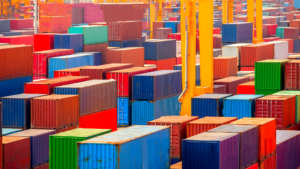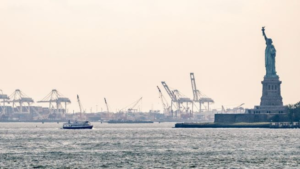Trans-Pacific Freight Rates Declining
Freight rates have been on a major decline since the September peak season.
Inflation, overstocked warehouses and a softening in consumer demand have contributed to the plummeting rates.
COVID caused major shortages which led to ocean carriers ramping up their manufacturing of containers to keep up with the market. The results? The market has stabilized somewhat and the supply of containers has outweighed the demand, lending to the drop in spot prices.
Ocean spot freight rates for a 40' container from China to Los Angeles decreased by 62% in July 2022 compared to September 2021 and by 59% compared to January 2022, reaching US $6,600.
Rates from China to New York fell 52% in July 2022 compared to September 2021 and 48% compared to January 2022, reaching US $9,300 in July 2022.
Although these rates are still a long way from the pre-pandemic levels of US$1,350/FEU and US$2,850/FEU in March 2020 on the US West and East Coasts respectively, this decrease is still a relief for the shippers.
So what’s keeping the rates higher than pre-pandemic levels? Congestion, that is. Containers are piling up at the ports, on the trains and in container yards.
All in all, this is great news!
Source: Container News
Shippers, truckers plead for FMC per diem relief amid NY-NJ empty box backlog
Truckers say they are increasingly hamstrung by handling empties, which have reached “crisis-level” at NY-NJ.
Shippers and truckers are asking the Federal Maritime Commission (FMC) to block ocean carriers from charging detention and demurrage fees at the Port of New York and New Jersey because the gateway’s “crisis-level” backlog of empty containers is hampering the ability to retrieve import loads.
The New Jersey-based Association of Bi-State Motor Carriers and the National Industrial Transportation League (NITL) sought the per diem waiver in separate letters to FMC Chairman Daniel Maffei.
The Bi-State's Tuesday letter to Maffei said the group’s 170 members are being severely affected by high numbers of empty containers that they are unable to return. The result is that import loads sit for longer, racking up per-diem fees.
The group said ocean carriers need to evacuate more empties to enable trucking operations to run smoothly in the port.
“The lack of return locations for empty containers has reached crisis-level proportions,” the Bi-State letter said. “Marine terminals in (New York and New Jersey) do not have sufficient storage capacity to take back all of the empty containers because the ocean carriers are not loading back these boxes in sufficient quantities.”
NITL on Wednesday also argued for the per diem waiver because shippers also bear the cost of empty returns through higher rates and delays in retrieving imports due to the extra handling of empties.
“This is adding enormous inefficiency and costs to the supply chain, and (beneficial cargo owners) are facing unreasonable chassis, storage, and detention fees,” the NITL said.
Six empty sweepers in June
Data from the PANYNJ shows that in June, six out of 14 ships that were not scheduled to arrive at the port were dispatched as empty sweepers. The remainder were extra loaders carrying imports. The number was little changed from May when five empty sweepers called out of 13 extra loaders not regularly scheduled to call the port.
Even before a two-year import surge had left thousands more empty containers stranded across the United States, Bi-State said it was trying to address the issue of empties with ocean carriers. After forming a stakeholder group in 2019 under the auspices of PANYNJ, Bi-State said its recommendations — including that ocean carriers “should make every effort” to pick up empties — remain unfulfilled. It said truckers continue to be plagued by ocean carriers blocking the return of empties to marine terminals.
“Nothing changed, and the problem grew worse,” the letter said.
Bi-State said empties are adding to already high port congestion by slowing the flow of imports off of marine terminals and adding to overall shipper costs. Drivers run out of their available service hours when they are required to return empties to off-port depots, while empties tie up scarce chassis that could be used for import loads, the group said.
Empty containers at the New York-New Jersey port are already a topic on the FMC’s radar. Last year, FMC Commissioner Carl Bentzel sent a letter to three major container alliances urging them to do more to sweep up empties from the port and find other ways to lessen the burden on truckers.
Source: JOC
Keeping Up with the Negotiations
On this week's episode of the International Longshore and Warehouse Union (ILWU) and the Pacific Maritime Association (PMA) negotiations -
The ILWU and the PMA have found some common ground. They’ve reached a tentative agreement on health benefits!
Next up on the agenda? Automation…
Currently three terminals — Long Beach Container Terminal, TraPac and the APM Terminal utilize automated operations.
The ILWU has expressed concern on multiple occasions.
The union’s president, Willie Adams, stated back in July 2020 that “losing jobs to automation not only undermines the long term capacity of our ports, but it does lasting damage on our families.”
In 2021, the ILWU denounced Total Terminals International (TTI), when the company announced its intentions to automate. TTI operates a facility at the Port of Long Beach’s Pier T.
ILWU Local 13 President Ramon Ponce de Leon charged that: “While foreign-owned corporations like TTI continue to push to fully automate their terminal operations at our publicly owned U.S. ports, they need to remember that the ports exist for the benefit of the U.S. and local economies, not the destruction of jobs and maximum extraction of foreign profit.”
The PMA, on the other hand, strongly believes otherwise. In a recent report the PMA commissioned, Dr. Michael Nacht and Larry Henry found that automated terminals increase the competitiveness of the Ports of Los Angeles and Long Beach: “As a result, cargo handling has grown rapidly, and paid hours for ILWU workers at LBCT (Long Beach Container Terminal) and TraPac (located at the Port of Los Angeles) were 31.5% higher in 2021 than in 2015, before the transition to automation began … That is more than twice the 13.9% growth in paid hours at San Pedro Bay’s non-automated terminals. Rather than reducing work for ILWU members, automation has raised demand for their services.”
As you can imagine, the report was not received well by the ILWU. It was harshly criticized for hiding the impact of job losses caused by automated operations at the Ports of Long Beach and Los Angeles.
Will they reach a conclusion? Maybe in August. Or September. Or October…




